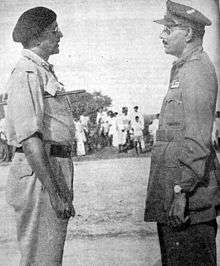Osmanistan
Osmanistan was a hypothetical name that was proposed by Choudhary Rahmat Ali (but which never materialised) for an independent state to be created as a successor to the Princely State of Hyderabad which existed in the Presidencies and Provinces of British India before the departure of the British. The princely states that existed before independence of India in 1947 were given the choice of joining one of the new dominions, Pakistan or India, or in some cases, remain independent. The Nizam of Hyderabad initially chose to join neither India nor Pakistan.[1] He later declared Hyderabad a free, self-governing independent state but the Government of India refused to accept his point of view as Hyderabad was surrounded by India on all sides and did not have access to the sea. When the Indian Army invaded his princely State on 13 September 1948 (see Operation Polo), his forces were unable to withstand the Indian army and were defeated. The Nizam was forced to accept accession to India. The former princely state was reorganised in 1956 and its territories are now parts of the current Indian states of Telangana, Maharashtra and Karnataka.

History
At the time of partition of British India and cessation of the British suzerainty over the princely states of India, the states had the choice of joining one of the new dominions, Pakistan or India, or remaining independent as per Article 2.4 of the Indian Independence Act 1947 passed by British parliament.
The Princely State of Hyderabad was a majority Hindu princely state with a Muslim ruler, Nizam Osman Ali Khan. Its politics were dominated by Muslim elite.[2] The Muslim nobility and the Ittehad-ul-Muslimeen, a powerful pro-Nizam Muslim party, insisted that Hyderabad must remain an independent state and stand on an equal footing to India and Pakistan. The Nizam was persuaded by the last British Viceroy, Lord Mountbatten not to join Pakistan.
The Nizam chose for his state to remain independent. He issued a firman announcing that Hyderabad would remain independent and not join the Union of India[3] but the Government of India rejected the firman, terming it a "legalistic claim of doubtful validity". His minister Kasim Razvi unfurled the Asafia Flag and declared that the flag was the emblem of the suzerainty of God on earth. The Deccan Chronicle newspaper of Hyderabad reported on 24 June 1947, "His Exalted Highness will assume Sovereign status and powers on or about August 15, 1947, by which time it is expected that the Indian and Pakistan areas would have assumed the status of Dominions of the British Common Wealth."[4] The word "Osmanistan" was never used.
On 13 September 1948 the Indian Army entered Hyderabad, which was unable to withstand the attack and was quickly overrun, with the last Nizam of Hyderabad Osman Ali Khan, Asaf Jah VII forced to surrender and accept accession to India.

For the reason of frailty, the idea of Osmanistan in Choudhary Rahmat Ali's scheme, was eventually let off in the demand for Pakistan as it was "impracticable" (because Hyderabad was surrounded by India on all sides and did not have an access to sea.)[5] The former princely state Hyderabad was reorganised in 1956 and its territories are now parts of the current Indian states of Maharashtra, Karnataka and Telangana.
Rahmat Ali’s plan
Chaudhry's scheme did not initially call for an Osmanistan. Later, on 8 March 1940, he proposed a new scheme for the establishment of Pakistan, Bangalistan (East Bengal) and Osmanistan. After the Muslim League's acceptance of the British partition plan on 3 June 1947 he issued a statement six days later called "The Great Betrayal" in asking for the rejection of the British plan and the acceptance of his Pakistan plan "to prevent the great evil of Hindu hegemony on Indian Muslims". In the end the British plan was accepted, and his was rejected for the aforementioned pragmatic reasons.[6]
Choudhry Rahmat Ali lived most of his adult life in England and came to Pakistan only on 6 April 1948. He died in February 1951 and was buried on 20 February at Newmarket Road Cemetery, Cambridge, UK.
See also
References
- ↑ Lumby, E.W.R. (1954), The Transfer of Power in India, 1945–1947, London: George Allen and Unwin
- ↑ Talbot, Phillips (1949), "Kashmir and Hyderabad", World Politics, Cambridge University Press, 1 (3): 321–332, doi:10.2307/2009033, JSTOR 2009033
- ↑ Lumby, E.W.R. (1954), The Transfer of Power in India, 1945–1947, London: George Allen and Unwin
- ↑ http://shodhganga.inflibnet.ac.in/bitstream/10603/1882/11/11_chapter7.pdf
- ↑ Cohen, Stephen P. (2004-09-21). The Idea of Pakistan. Brookings Institution Press. ISBN 0815797613.
- ↑ Cohen, Stephen P. (2004-09-21). The Idea of Pakistan. Brookings Institution Press. p. 52. ISBN 0815797613.
